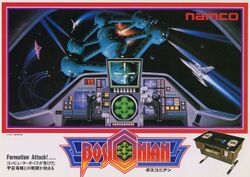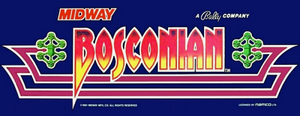This is the first game in the Bosconian series. For other games in the series see the Bosconian category.

| Bosconian | |
|---|---|
| Developer(s) | Namco |
| Publisher(s) | Namco, Midway Games |
| Year released | 1981 |
| System(s) | Arcade, MSX, Commodore 64/128, Amstrad CPC |
| Followed by | Blast Off |
| Series | Bosconian, Arcade Archives |
| Japanese title | ボスコニアン |
|---|---|
| Genre(s) | Shooter |
| Players | 1-2 |
| Modes | Single player, Multiplayer |
| Arcade Archives Bosconian | |
|---|---|
| Developer(s) | Namco |
| Publisher(s) | Hamster Corporation |
| Year released | 2023 |
| System(s) | Nintendo Switch, PlayStation 4 |
| Rating(s) | |
Bosconian is a multi-directional shooter arcade game that was released by Namco in 1981 and licensed to Midway Games for U.S. manufacture and distribution. It runs on Namco Galaga hardware (three Zilog Z80 microprocessors running at 3.125 MHz), and was the last of three pre-M6809 games from the company whose score displays did not roll over at 1,000,000. After Namco succeeded in improving their own Rally-X with the release of New Rally-X, Namco investigated what other forms of gameplay could be developed to exploit the hardware that New Rally-X ran on. The result was Bosconian. One notable feature of the game is its use of digitized voice samples, which Namco had first developed for their own King and Balloon. Another is that it was the first arcade game to offer a continue feature, which can be turned off by the arcade operator if he wants to prevent overspending.
The focus of Bosconian is to fly around through space in search of the large green enemy bases, and blow them up. You pilot a ship that can fire in two directions; in front and behind. But the enemy doesn't simply let you destroy their valuable stations. They will send a variety of missiles at you, some in formations, in an attempt to stop you from succeeding in your one-man mission.
Despite being picked up by Midway Games for distribution in the United States, Bosconian never developed a large following outside of Japan. As a result, the only home conversions that it saw were for popular Japanese home computers like the MSX and the Sharp X68000 (which received an altered, graphically enhanced version of the game). A sequel to this game named Blast Off was released in 1989 in Japan. It was a vertical scrolling shooter, and had more in common with Namco's Dragon Spirit than with its predecessor. The story of Bosconian was followed up by Namco's Famicom entry Star Luster, which has completely different gameplay (and a Vs. System game), but takes place several hundred years after the Bosconian Wars took place.
Story[edit]
How the Bosconian Wars started, no one knows. The Federal Council suffered massive losses to the Bosconian enemy's seemingly impenetrable enemy base fortress. But the Federal Council's luck was about to change. A daring plan to send a spy in among the Bosconians finally paid off. The building plans for the enemy bases were finally revealed. The Council set about constructing a prototype Star Fighter, which was armed with the capability to exploit the enemy bases' weaknesses. With only so much material, and so little time, they could only prepare a few of these precious ships. In order to attract a little attention as possible, they would go in one at a time, and try to launch a strike against the enemy base in each sector of space before the enemy could realize what was happening and retaliate. The Bosconian War was about the close...
Table of Contents

Gameplay summary[edit]

- You pilot the Star Fighter, which can fly in eight directions (the first Namco character to do so), and fire simultaneously in two; in front and behind.
- Each round contains a number of Enemy Bases that are visible on the radar, which is located on the right side of the screen (much like Rally-X).
- In order to advance to the next round, all Enemy Bases must be destroyed, either by hitting all six cannons on the outside, or blowing up the core.
- The Enemy Bases will defend themselves with shots, and later on, missiles. In addition enemy missiles will appear to destroy your Star Fighter.
- Your Star Fighter will lose a life if it is flown into by an enemy missile or spy ship, or if it flies into an enemy bullet, asteroid, mine or Enemy Base.
- The combat computer will alert you to the formations' presences ("Battle Stations!"), or if you have been detected by a spy ship ("Condition Red!").
